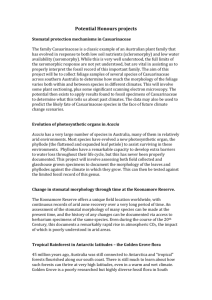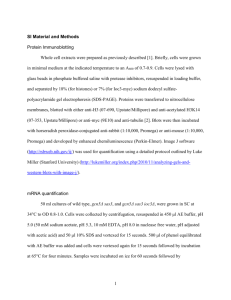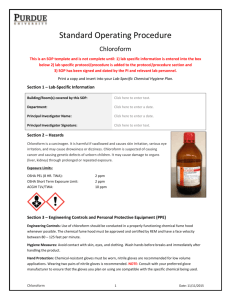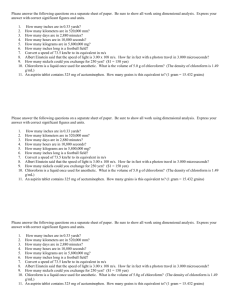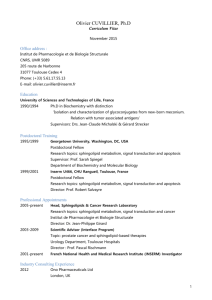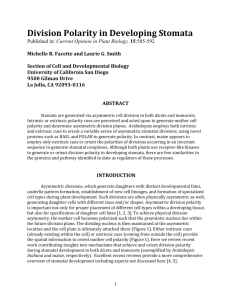Word file (28 KB )
advertisement
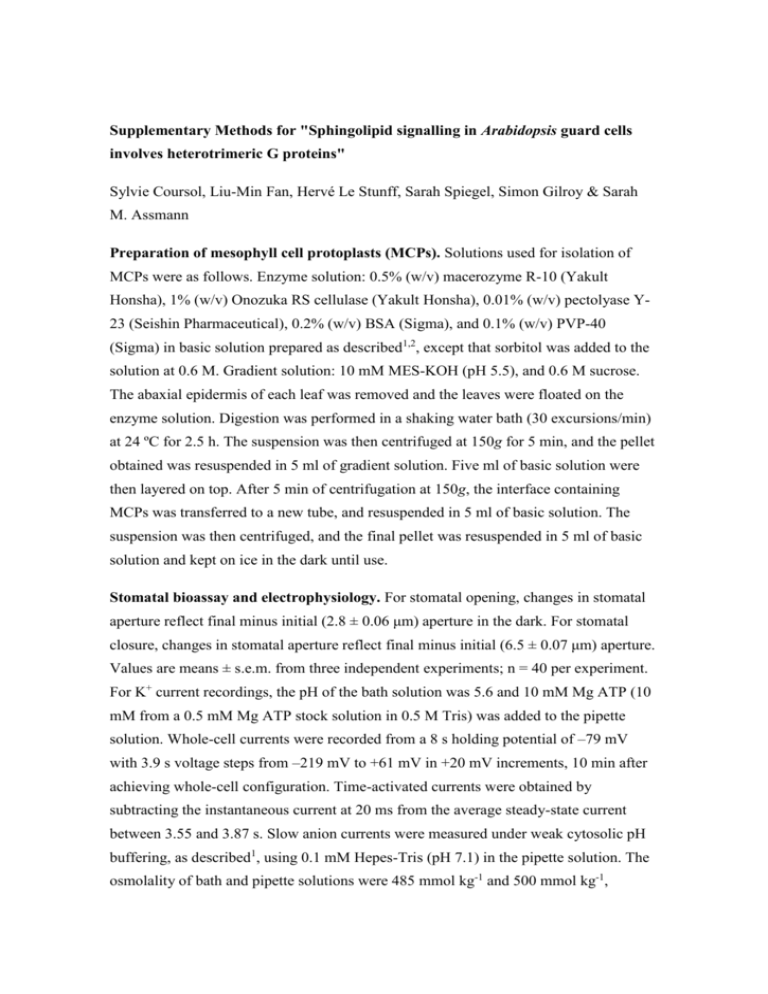
Supplementary Methods for "Sphingolipid signalling in Arabidopsis guard cells involves heterotrimeric G proteins" Sylvie Coursol, Liu-Min Fan, Hervé Le Stunff, Sarah Spiegel, Simon Gilroy & Sarah M. Assmann Preparation of mesophyll cell protoplasts (MCPs). Solutions used for isolation of MCPs were as follows. Enzyme solution: 0.5% (w/v) macerozyme R-10 (Yakult Honsha), 1% (w/v) Onozuka RS cellulase (Yakult Honsha), 0.01% (w/v) pectolyase Y23 (Seishin Pharmaceutical), 0.2% (w/v) BSA (Sigma), and 0.1% (w/v) PVP-40 (Sigma) in basic solution prepared as described1,2, except that sorbitol was added to the solution at 0.6 M. Gradient solution: 10 mM MES-KOH (pH 5.5), and 0.6 M sucrose. The abaxial epidermis of each leaf was removed and the leaves were floated on the enzyme solution. Digestion was performed in a shaking water bath (30 excursions/min) at 24 ºC for 2.5 h. The suspension was then centrifuged at 150g for 5 min, and the pellet obtained was resuspended in 5 ml of gradient solution. Five ml of basic solution were then layered on top. After 5 min of centrifugation at 150g, the interface containing MCPs was transferred to a new tube, and resuspended in 5 ml of basic solution. The suspension was then centrifuged, and the final pellet was resuspended in 5 ml of basic solution and kept on ice in the dark until use. Stomatal bioassay and electrophysiology. For stomatal opening, changes in stomatal aperture reflect final minus initial (2.8 ± 0.06 μm) aperture in the dark. For stomatal closure, changes in stomatal aperture reflect final minus initial (6.5 ± 0.07 μm) aperture. Values are means ± s.e.m. from three independent experiments; n = 40 per experiment. For K+ current recordings, the pH of the bath solution was 5.6 and 10 mM Mg ATP (10 mM from a 0.5 mM Mg ATP stock solution in 0.5 M Tris) was added to the pipette solution. Whole-cell currents were recorded from a 8 s holding potential of –79 mV with 3.9 s voltage steps from –219 mV to +61 mV in +20 mV increments, 10 min after achieving whole-cell configuration. Time-activated currents were obtained by subtracting the instantaneous current at 20 ms from the average steady-state current between 3.55 and 3.87 s. Slow anion currents were measured under weak cytosolic pH buffering, as described1, using 0.1 mM Hepes-Tris (pH 7.1) in the pipette solution. The osmolality of bath and pipette solutions were 485 mmol kg-1 and 500 mmol kg-1, respectively. Whole-cell currents were recorded from a 12 s holding potential of +30 mV with 50 s voltage steps from –145 mV to +35 mV in +30 mV increments, 12 min after achieving whole-cell configuration. Steady-state currents were acquired by subtracting the basal current at a holding potential of +30 mV from the average current between 42.5 and 50.0 s. Data were simultaneously compared using Scheffe’s method, and only results with a P-value 0.05 were considered statistically significant. Preparation of sphingolipid solutions. Sphingosine, D-erythro-dihydrosphingosine, DL-threo-dihydrosphingosine, N,N-dimethylsphingosine, sphingosine-1-phosphate, and D-erythro-dihydrosphingosine-1-phosphate were from Biomol. For sphingosine kinase (SphK) assays, sphingoid bases were prepared as complexes with fatty acid free BSA3 (final concentration 0.2 mg ml-1). Phosphorylation assays. SphK assays4 were performed with leaf lysates. The labelled lipids in the organic phase were dried under a stream of N2 and resuspended in 4 ml of a basic aqueous phase [methanol/1 M NaCl/3 N NaOH (1:1:0.1, v/v/v)]. Hydrolysis buffer [900 l, 200 mM Tris-HCl (pH 7.5), 1.2 M glycine (pH 9.0), 75 mM MgCl2] and 100 units of alkaline phosphatase were added. After 30 min at 37 °C, 80 l of concentrated HCl were added, and sphingoid bases were extracted with 3 ml of chloroform. The organic phase was then re-extracted with 3 ml of chloroform. The aqueous phase fractions were combined, dried under a stream of N2, and then resuspended in kinase buffer with 0.2 mg ml-1 BSA. Reactions were started by the addition of [-32P]ATP (10 Ci, 1 mM) containing 10 mM MgCl2, and 10 g of recombinant human SphK1. After 30 min at 37 °C, 40 l of 2 N HCl and 500 l of chloroform/methanol/concentrated HCl (100:200:1, v/v/v) were added. The samples were mixed thoroughly, and 250 µl chloroform and 250 µl 2 M KCl were added. The labelled lipids in the organic phase were separated by TLC with chloroform/acetone/methanol/acetic acid/water (10:4:3:2:1, v/v/v/v) and visualized with a PhosphorImager (Molecular Dynamics Storm). References 1. Wang, X.-Q., Ullah, H., Jones, A. M. & Assmann, S. M. G protein regulation of ion channels and abscisic acid signaling in Arabidopsis guard cells. Science 292, 2070-2072 (2001). 2. Pandey, S., Wang, X.-Q., Coursol, S. & Assmann, S. M. Preparation and applications of Arabidopsis thaliana guard cell protoplasts. New Phytol. 153, 517-526 (2002). 3. Liu, H. et al. Molecular cloning and functional characterization of a novel mammalian sphingosine kinase type 2 isoform. J. Biol. Chem. 275, 19513-19520 (2000). 4. Olivera, A., Kohama, T., Tu, Z., Milstien, S. & Spiegel, S. Purification and characterization of rat kidney sphingosine kinase. J. Biol. Chem. 273, 12576-12583 (1998).
